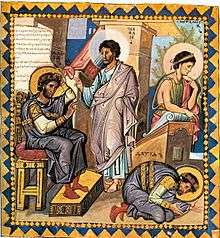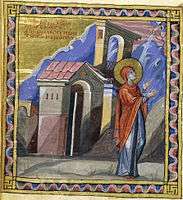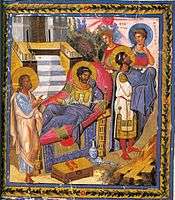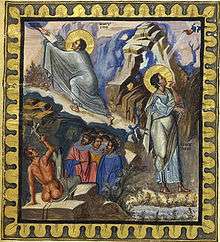Paris Psalter

The Paris Psalter (Paris, Bibliothèque Nationale, MS. gr. 139), designated by siglum 1133 (Rahlfs), is a Byzantine illuminated manuscript containing 449 folios and 14 full-page miniatures "in a grand, almost classical style", as the Encyclopædia Britannica put it. Together with Basil I's Homilies of St Gregory Nazianzus, the Paris Psalter is considered a key monument of the so-called Macedonian Renaissance in Byzantine art during the 10th century.
The discovery that images such as David composing the psalms surrounded by personifications were clearly derived from Greco-Roman wall painting led 19th-century scholars to date the manuscript to the early 6th century. In the early 20th century, however, Hugo Buchthal and Kurt Weitzmann, took issue with the Late Antique dating, conclusively demonstrating that the fully realized, confident classicism and illusionism of the miniatures were the product of the 10th century, thereby extending the persistence of classical art in Byzantium into the Middle Ages.[1][2]
Miniatures
 The Reproach of Nathan and the Penance of King David (folio 136v)
The Reproach of Nathan and the Penance of King David (folio 136v) Hannah's Prayer (folio 428v)
Hannah's Prayer (folio 428v) The Healing of Hezekiah (folio 446v)
The Healing of Hezekiah (folio 446v) Isaiah's Prayer (folio 435v)
Isaiah's Prayer (folio 435v) Moses Receiving the Commandments (folio 422v)
Moses Receiving the Commandments (folio 422v) David Glorified by the Women of Israel (folio 5v)
David Glorified by the Women of Israel (folio 5v)
See also
- Castelseprio (frescoes in a related style)
- Macedonian Renaissance
- Macedonian art (Byzantine)
- Leo Bible
Notes
References
- Kaya, İlkgül. "Paris Psalterionu (Cod. Gr. 139, Paris-Ulusal Kütüphane) ve Makedonyan Rönesansı." Sanat ve Estetikte Asal Değerler, Ankara Üniversitesi Dil ve Tarih-Coğrafya Fakültesi Sanat Tarihi Bölümü, Ankara 2015.
- Walther, Ingo F. and Norbert Wolf. Codices Illustres: The world's most famous illuminated manuscripts, 400 to 1600. Köln:Taschen, 2005.
- Steven H. Wander, “The Paris Psalter (Paris, Bibliothèque Nationale, cod. gr. 139) and the Antiquitates Judaicae of Flavius Josephus,” Word & Image: A Journal of Verbal/Visual Inquiry vol. 30:2 (June, 2014), pp. 90–103
External links
| Wikimedia Commons has media related to Paris Psalter. |
- The digitization of the Paris Psalter by the Bibliothèque nationale de France.
- a paper by İlkgül Kaya Zenbilci
- The glory of Byzantium: Art and Culture of the Middle Byzantine Era, A.D. 843-1261, an exhibition catalog from The Metropolitan Museum of Art (fully available online as PDF), which contains material on the Paris Psalter (cat no 163)